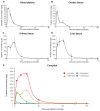Evaluation of Ouabain's Tissue Distribution in C57/Black Mice Following Intraperitoneal Injection, Using Chromatography and Mass Spectrometry
- PMID: 38673903
- PMCID: PMC11050293
- DOI: 10.3390/ijms25084318
Evaluation of Ouabain's Tissue Distribution in C57/Black Mice Following Intraperitoneal Injection, Using Chromatography and Mass Spectrometry
Abstract
Cardiotonic steroids (CTSs), such as digoxin, are used for heart failure treatment. However, digoxin permeates the brain-blood barrier (BBB), affecting central nervous system (CNS) functions. Finding a CTS that does not pass through the BBB would increase CTSs' applicability in the clinic and decrease the risk of side effects on the CNS. This study aimed to investigate the tissue distribution of the CTS ouabain following intraperitoneal injection and whether ouabain passes through the BBB. After intraperitoneal injection (1.25 mg/kg), ouabain concentrations were measured at 5 min, 15 min, 30 min, 1 h, 3 h, 6 h, and 24 h using HPLC-MS in brain, heart, liver, and kidney tissues and blood plasma in C57/black mice. Ouabain was undetectable in the brain tissue. Plasma: Cmax = 882.88 ± 21.82 ng/g; Tmax = 0.08 ± 0.01 h; T1/2 = 0.15 ± 0.02 h; MRT = 0.26 ± 0.01. Cardiac tissue: Cmax = 145.24 ± 44.03 ng/g (undetectable at 60 min); Tmax = 0.08 ± 0.02 h; T1/2 = 0.23 ± 0.09 h; MRT = 0.38 ± 0.14 h. Kidney tissue: Cmax = 1072.3 ± 260.8 ng/g; Tmax = 0.35 ± 0.19 h; T1/2 = 1.32 ± 0.76 h; MRT = 1.41 ± 0.71 h. Liver tissue: Cmax = 2558.0 ± 382.4 ng/g; Tmax = 0.35 ± 0.13 h; T1/2 = 1.24 ± 0.7 h; MRT = 0.98 ± 0.33 h. Unlike digoxin, ouabain does not cross the BBB and is eliminated quicker from all the analyzed tissues, giving it a potential advantage over digoxin in systemic administration. However, the inability of ouabain to pass though the BBB necessitates intracerebral administration when used to investigate its effects on the CNS.
Keywords: blood plasma; brain; brain–blood barrier; cardiac tissue; cardiotonic steroids; digoxin; kidney; liver; ouabain.
Conflict of interest statement
The authors declare no conflicts of interest.
Figures





Similar articles
-
Ouabain-digoxin antagonism in rat arteries and neurones.J Physiol. 2014 Mar 1;592(5):941-69. doi: 10.1113/jphysiol.2013.266866. Epub 2013 Dec 16. J Physiol. 2014. PMID: 24344167 Free PMC article.
-
Digoxin increases hydrogen sulfide concentrations in brain, heart and kidney tissues in mice.Pharmacol Rep. 2011;63(5):1243-7. doi: 10.1016/s1734-1140(11)70645-4. Pharmacol Rep. 2011. PMID: 22180368
-
Intraperitoneal administration of the antitumour agent N-[2-(dimethylamino)ethyl]acridine-4-carboxamide in the mouse: bioavailability, pharmacokinetics and toxicity after a single dose.Cancer Chemother Pharmacol. 1992;31(1):32-6. doi: 10.1007/BF00695991. Cancer Chemother Pharmacol. 1992. PMID: 1458557
-
Whither digitalis? What we can still learn from cardiotonic steroids about heart failure and hypertension.Am J Physiol Heart Circ Physiol. 2022 Dec 1;323(6):H1281-H1295. doi: 10.1152/ajpheart.00362.2022. Epub 2022 Nov 11. Am J Physiol Heart Circ Physiol. 2022. PMID: 36367691 Review.
-
Endogenous cardiac glycosides, a new class of steroid hormones.Eur J Biochem. 2002 May;269(10):2440-8. doi: 10.1046/j.1432-1033.2002.02911.x. Eur J Biochem. 2002. PMID: 12027881 Review.
Cited by
-
Mechanisms mediating effects of cardiotonic steroids in mammalian blood cells.Front Pharmacol. 2025 Mar 24;16:1520927. doi: 10.3389/fphar.2025.1520927. eCollection 2025. Front Pharmacol. 2025. PMID: 40196366 Free PMC article. Review.
References
-
- Lopachev A.V., Lopacheva O.M., Osipova E.A., Vladychenskaya E.A., Smolyaninova L.V., Fedorova T.N., Koroleva O.V., Akkuratov E.E. Ouabain-induced changes in MAP kinase phosphorylation in primary culture of rat cerebellar cells. Cell Biochem. Funct. 2016;34:367–377. doi: 10.1002/cbf.3199. - DOI - PubMed
-
- Neves C.H., Tibana R.A., Prestes J., Voltarelli F.A., Aguiar A.F., Mota G.A.F., de Sousa S.L.B., Leopoldo A.S., Leopoldo A.P.L., Mueller A., et al. Digoxin Induces Cardiac Hypertrophy without Negative Effects on Cardiac Function and Physical Performance in Trained Normotensive Rats. Int. J. Sports Med. 2017;38:263–269. doi: 10.1055/s-0042-119727. - DOI - PubMed
-
- Marck P.V., Pessoa M.T., Xu Y., Kutz L.C., Collins D.M., Yan Y., King C., Wang X., Duan Q., Cai L., et al. Cardiac Oxidative Signaling and Physiological Hypertrophy in the Na/K-ATPase α1s/sα2s/s Mouse Model of High Affinity for Cardiotonic Steroids. Int. J. Mol. Sci. 2021;22:3462. doi: 10.3390/ijms22073462. - DOI - PMC - PubMed
MeSH terms
Substances
Grants and funding
LinkOut - more resources
Full Text Sources
Research Materials
Miscellaneous

